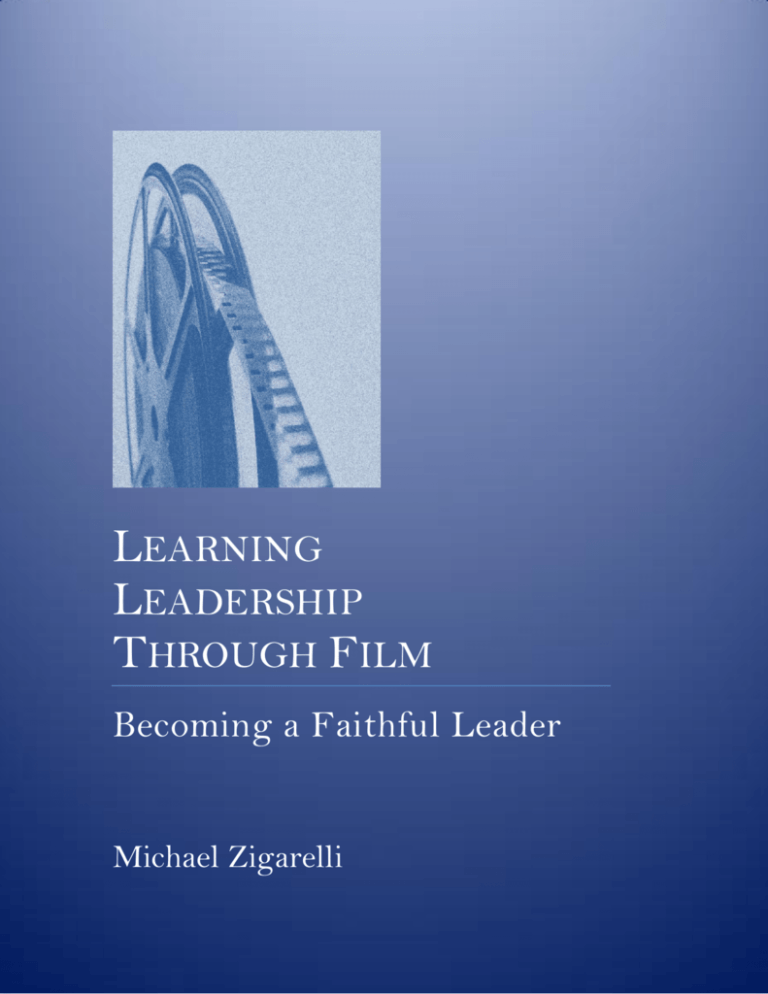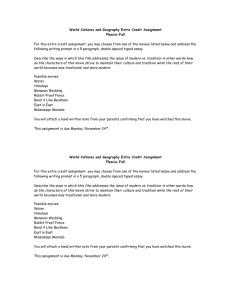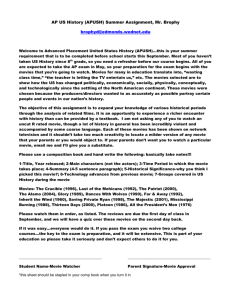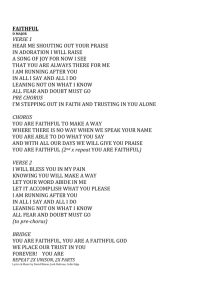
LEARNING
LEADERSHIP
THROUGH FILM
Becoming a Faithful Leader
Michael Zigarelli
0
Recommended Movies for this Study
download the discussion questions for these movies
Alternative Movies for this Study
download the discussion questions for these movies
12 Angry Men
12 O’clock High
13 Days
Braveheart
Captain Phillips
Chariots of Fire
Courageous
Facing the Giants
Fireproof
Freedom Writers
Gandhi
Iron Lady
The Jesus Film
Lean on Me
Lincoln
Miracle
The Miracle Worker
Mr. Holland’s Opus
Moneyball
Norma Rae
Remember the Titans
Shadowlands
Searching for Bobby Fischer
Shattered Glass
Stand and Deliver
Wall Street
1
Contents
How This Study Works
3
Faithful Leadership: Why is This Difficult?
5
Faithful Leadership: What Does It Look Like?
HUMILITY, NOT PRIDE
From Self to Service
6
ENCOURAGEMENT, NOT JUDGMENT
From Criticism to Compliments
8
INTEGRITY, NOT DUPLICITY
From Crafty to Credible
9
RECONCILIATION, NOT REVENGE
From Payback to Patience
10
PASSION, NOT PASSIVITY
From Complacent to Committed
11
EXCELLENCE, NOT MEDIOCRITY
From Quantity to Quality
12
SIMPLICITY, NOT OVERLOAD
From Frenetic to Focused
13
COURAGE, NOT FEAR
From Worried to Willing
14
Faithful Leadership: How Can I Get There?
15
© 2014 by Michael Zigarelli. All Rights Reserved.
2
How This Study Works
This is a ten session, self-paced study intended to help you develop into a more
effective leader. You can complete it alone or with a friend or with an entire
group or class. The design permits you to customize it to your needs.
Rather than build leadership skills, though, this study intends to build leadership
character, since the latter is a prerequisite for proper use of the former. We can all
think of leaders in our life and throughout history who have had the necessary
skills but not the necessary character to lead, culminating in poor or even
disastrous results. It happens in the political arena, in the workplace, in our
schools, on our ball fields, in our churches, in our homes and in many other
contexts.
We might also have known some leaders who are exemplary role models of both
character and influence. That’s the target, to grow in that direction—to develop
a God-honoring inner life that naturally results in a more effective outer life,
more effective leadership of individuals and teams and organizations. The target
is to become a “faithful leader.”
As you can see, what you’re about to embark on is not traditional leadership
training, but a personal development experience. And it’s built on stories, movies
to be more exact. Through this entertaining approach, we hope you’ll catch an
inspiring vision for what it means to be a faithful leader—a person who leads
others by following God. There are many resources connected to this study,
most of them free, to help you pursue that vision in whatever depth you’d like.
Our premise is this: There’s a different basis on which we can lead, at work, at
home or anywhere else. For those who want to make a difference in the world, or
at least the small corner of the world to which you’re called, it’s time to begin
that journey.
First, though, some quick logistics.
How This Works and What You’ll Need
Essentially, this study works however you’d like it to work. It’s got a flexible
format that permits you to tailor it to your needs and interests. Skip around,
select alternative movies, spend as much or as little time as you want on a topic.
3
There is a recommended structure to it, though: Watch the teaching video, study
the suggested readings, enjoy the movie or movies that correspond to the topic,
and complete the “experiential exercise.” You can also go further with any of the
topics in this study through the “Digging Deeper” materials.
Most of the readings for this study are online and freely available. However, one
important resource is not free, Richard Foster’s book Celebration of Discipline, so
for the complete experience, you’ll need to purchase or borrow that.
Also, for upper level undergraduates, grad students and professionals, you’ll see
that we recommend several leadership articles from Harvard Business Review.
Harvard permits access to four free articles per month, so you can read these for
no charge if you create an account here (no credit card required) and then use
their search box to find the articles.
The centerpiece of the study, though, is the movie collection. That’s why we call
it “Learning Leadership Through Film.” Find the most convenient method to
access each movie (Netflix, Amazon Prime, rent or buy the DVD, etc.) and then
watch closely. For each movie, you’ll also find downloadable discussion questions
for classroom or personal use. It’s best to review these discussion questions
before watching the movie, so you’ll know what you’re looking for. Then, as the
movie runs, take some good notes under each question.
Of course, this is not how we normally watch movies. We sit back and we’re
entertained by them. But if you treat the movies in this study that way, you may
miss something important—the specific connections to the leadership topic
you’re exploring.
So our advice is that you do more than break out the popcorn and watch some
movies. Instead, while you’re munching, study the movies. The leaders we
consider are not always ideal role models; many of them struggle just as we do.
But to enhance your learning, put yourself in the shoes of these protagonists.
Examine their situation in light of the teaching and readings for that topic. In
doing so, you’ll glean much more and, if you’re completing this study with
others, you’ll have more valuable insights to offer them.
The point is this: There are essential leadership lessons in each of these movies.
Try not to let them become obscured by reducing this experience to mere
entertainment.
Okay, enough of the previews. Let’s get to our feature presentations.
4
WEEK 1
Faithful Leadership: Why is This Difficult?
ACTIVITY 1: View “The Case of ‘Successful’ Sam” and reflect on and/or discuss
two questions: “What dysfunctions do you see in Sam’s life and leadership?” and
“What do you think has shaped his thinking about how to lead at work and at
home?” (in Week 10 of this study we will deal with the question of “what should
Sam do?” so hold off on that for now).
ACTIVITY 2: After considering the Sam video, watch the Week 1 teaching video,
“Faithful Leadership: Why is This Difficult?” for some perspective about what
may shape our leadership style and decisions. Reflect on and/or discuss the
concepts presented in this video.
EXPERIENTIAL EXERCISE: During the next 24 hours look for the hidden or
underlying messages around you. Consider advertisements, movies, TV shows,
magazine articles, music lyrics, YouTube, Facebook friends, and so on, and
compare the underlying assumptions to what might be a Christian or Biblical
worldview. If possible, discuss your observations with at least one other person.
DIGGING DEEPER
On worldview and cultural influences:
Naming the Elephant and The Universe Next Door, James Sire
Total Truth, Nancy Pearcey
“The Pied Piper of Peoria,” Michael Zigarelli
The Screwtape Letters, C.S. Lewis, Chapter 10
5
WEEK 2
FAITHFUL LEADERSHIP: WHAT DOES IT LOOK LIKE?
Humility, Not Pride
From Self to Service
ACTIVITY 1: Watch the Week 2 teaching video, “Faithful Leadership: Humility,
Not Pride,” to examine what this looks like in a leader.
ACTIVITY 2: Read the following excerpts and reflect on or discuss the authors’
ideas. These are insights that have benefitted many over the past several decades.
“The Great Sin,” C.S. Lewis, from Mere Christianity
“Must I Listen?” Oswald Chambers, from My Utmost for His Highest
ACTIVITY 3: Watch the movie The Blind Side, taking notes
based on these discussion questions. If possible, discuss your
observations with at least one other person.
EXPERIENTIAL EXERCISE: Complete three estimates of pride
that you heard about in Activity 1: (1) your signature, (2)
how much other people’s pride (boasting, me-first attitude,
snubbing you, etc.) bothers you and (3) the 10-question pride
estimate. Reflect on and/or discuss the results.
DIGGING DEEPER
How to grow humility:
Read Celebration of Discipline, Richard Foster, Chapter 9
Watch the movie The Ultimate Gift, taking notes based on
these discussion questions. If possible, discuss your
observations with at least one other person.
Experiential Exercise: Perform some type of significant
but hidden service (see Celebration of Discipline, Chapter 9)
and reflect on the experience.
6
Some other movies to examine humility and servant leadership:
The Jesus Film
Mr. Holland’s Opus
The Miracle Worker
Other readings on humility and pride:
The Screwtape Letters, C.S. Lewis, Chapter 14
“Benedict’s twelve steps to humility” (520 AD) and an application of these
steps to leadership: “Leading with the Head Bowed Down: Lessons in
Leadership Humility from the Rule of St. Benedict of Nursia” by Corne
Bekker
7
WEEK 3
FAITHFUL LEADERSHIP: WHAT DOES IT LOOK LIKE?
Encouragement, Not Judgment
From Criticism to Compliments
ACTIVITY 1: Watch the Week 3 teaching video, “Faithful Leadership: The Power
of Encouragement,” to examine the theology and practice of encouraging others.
ACTIVITY 2: Watch the movie Dead Poets Society, taking notes
based on these discussion questions. If possible, discuss your
observations with at least one other person.
EXPERIENTIAL EXERCISE: When you get dressed in the
morning, put five coins in your right pocket to remind you to
compliment or encourage at least five people that day. Then,
with each encouragement, move one coin from your right
pocket to your left pocket, ensuring that all five are in the left
pocket by the end of the day. Reflect on the experience and
repeat it with a few more coins the next day.
DIGGING DEEPER
Encouragement in leadership: Encouraging the Heart (James Kouzes and Barry
Posner, 2003). Here is an excerpt.
Encouragement in a team or group: A team-building exercise
Encouragement in everyday life: A practical sermon about encouragement
from North Point Community Church
Other movies to examine encouragement in leadership:
Stand and Deliver
Freedom Writers
8
WEEK 4
FAITHFUL LEADERSHIP: WHAT DOES IT LOOK LIKE?
Integrity, Not Duplicity
From Crafty to Credible
ACTIVITY 1: Watch the Week 4 teaching video, “Faithful Leadership: Integrity,
Not Duplicity,” to examine the science and the scriptures pertaining to honesty.
ACTIVITY 2: Read the following for potential answers to the question posed at
the end of the video from Activity 1. Discuss with others, if possible.
Read “Why Be Honest if Honesty Doesn’t Pay?” (Harvard Business Review,
September 1990) with special attention to the first three pages.
Read “The Fire and the Calf,” Rev. Phillips Brooks, preached in London, 1883
ACTIVITY 3: Watch the movie Quiz Show, taking notes based
on these discussion questions. If possible, discuss your
observations with at least one other person.
EXPERIENTIAL EXERCISE: For 24 consecutive hours, do not
misrepresent or exaggerate anything to anyone. Reflect on
the experience. (Alternative, if you think this exercise would
get you into too much trouble: For 24 consecutive hours,
count the number of times that you feel tempted to
misrepresent or shade the truth about something.)
DIGGING DEEPER
Article: “What Followers Expect from Their Leaders,” James Kouzes and Barry
Posner, Management Review, 1990
Other movies to examine integrity in leadership and life:
Wall Street
Fireproof
Shattered Glass
9
WEEK 5
FAITHFUL LEADERSHIP: WHAT DOES IT LOOK LIKE?
Reconciliation, Not Revenge
From Payback to Patience
ACTIVITY 1: Watch the Week 5 teaching video, “Faithful Leadership:
Reconciliation, Not Revenge,” to examine the temptation to retaliate.
ACTIVITY 2: Read the following perspectives from the 15th and 19th centuries.
Discuss with others, if possible.
“Time-Honored Advice for Coping with Your Boss” adapted from Thomas à
Kempis, The Imitation of Christ
“The Hardest Prayer of All: Praying for Our Enemies” Rev. G.D. Watson,
from Soul Food
ACTIVITY 3: Watch the movie Invictus, taking notes based on
these discussion questions. If possible, discuss your
observations with at least one other person.
EXPERIENTIAL EXERCISE: Attempt to pray in earnest for at
least five minutes for someone you dislike. Reflect on the
experience.
DIGGING DEEPER
Other movies to examine reconciliation and patience in leadership:
Gandhi
13 Days
Remember the Titans
12 Angry Men
Other resources on conflict and its resolution:
The Screwtape Letters, C.S. Lewis, Chapter 3
Getting to Yes: Negotiating an Agreement Without Giving In, Roger Fisher,
William Ury, and Bruce Patton. See also the sequel, Getting Past No.
Video: “Ten Commandments for Difficult Conversations”
10
WEEK 6
FAITHFUL LEADERSHIP: WHAT DOES IT LOOK LIKE?
Passion, Not Passivity
From Complacency to Commitment
ACTIVITY 1: Read “Level 5 Leadership” (Harvard Business Review, July 2005)
considering closely the author’s scientific conclusions about what makes an
effective leader. Discuss with others, if possible.
ACTIVITY 2: Watch the Week 6 teaching video, “Faithful Leadership: Passion,
Not Passivity,” to examine the science and scriptures on passion (i.e., zeal,
drivenness, determination) in leadership.
ACTIVITY 3: Watch the movie Amazing Grace, taking notes
based on these discussion questions. If possible, discuss your
observations with at least one other person.
EXPERIENTIAL EXERCISE: Starting with your “passion”
areas, complete the “Career Clarification Exercise”
(Appendix 1) to identify potential new directions for your
career. Be sure to identify only those directions that are
within the intersection of these circles (i.e., that are
consistent with your passions, strengths, and resource
needs).
DIGGING DEEPER
Other movies to examine drivenness and determination in leadership:
Lincoln
The Iron Lady
Braveheart
11
WEEK 7
FAITHFUL LEADERSHIP: WHAT DOES IT LOOK LIKE?
Excellence, Not Mediocrity
From Quantity to Quality
ACTIVITY 1: Watch the Week 7 teaching video, “Faithful Leadership: Excellence
as a Way of Life,” to examine the theology of excellence.
ACTIVITY 2: Read the following and, if possible, discuss the authors’ ideas with
others.
“Do Your Job as Jesus Would Do It,” Dallas Willard, excerpted from The
Divine Conspiracy
Celebration of Discipline, Richard Foster, Chapter 5 (especially his proposed
“Four Steps”)
“How the Best Get Better and Better,” Harvard Business Review, June 2008
ACTIVITY 3: Watch the movie Akeelah and the Bee, taking
notes based on these discussion questions. If possible, discuss
your observations with at least one other person.
EXPERIENTIAL EXERCISE: Select any reading from this week
and attempt to put its ideas into practice for at least 24 hours,
ideally longer. Reflect on and/or discuss your experience.
DIGGING DEEPER
Article: “The Making of an Expert,” Harvard Business Review, July-August 2007
Other movies that illustrate the pursuit of excellence:
Facing the Giants
12 O’clock High
Captain Phillips
Searching for Bobby Fischer
Chariots of Fire
12
WEEK 8
FAITHFUL LEADERSHIP: WHAT DOES IT LOOK LIKE?
Simplicity, Not Overload
From Frenetic to Focused
ACTIVITY 1 (individual simplicity): Watch the Week 8 teaching video, “The
Epidemic of Overload” and read about a Biblically-based solution in Celebration of
Discipline, Chapter 6 (with special attention to the first half of the chapter).
ACTIVITY 2 (organizational simplicity): Watch the brief video “Simplicity as
Competitive Advantage” and read “Simplicity-Minded Management” (Harvard
Business Review, December 2007) to examine how focusing and streamlining an
organization generates better long-term performance.
ACTIVITY 3: Watch the movie Jobs, taking notes based on
these discussion questions. If possible, discuss your
observations with at least one other person.
EXPERIENTIAL EXERCISE: Complete the “24 Hour Time
Audit” (Appendix 2; for better results, complete this for two or
three consecutive days). Identify areas where you may be
investing too much or too little time and consider how you
may simplify, doing “fewer things with more excellence.”
DIGGING DEEPER
Articles:
“Overloaded Circuits: Why Smart People Under-Perform,” Harvard Business
Review, January 2005
“The Real Leadership Lessons of Steve Jobs.” Harvard Business Review, April
2012
Other movies that illustrate leadership that is intensely-focused:
Miracle (2004)
13
WEEK 9
FAITHFUL LEADERSHIP: WHAT DOES IT LOOK LIKE?
Courage, Not Fear
From Worried to Willing
ACTIVITY 1: Watch the Week 9 Teaching Video, “Faithful Leadership: Courage,
Not Fear” for an overview of why courage is essential to leading change.
ACTIVITY 2: Review and discuss these brief resources:
Read the article Every Great Leader Has This Quality (Forbes Magazine)
View the video Dealing with Resistance to Change on having the courage to
remove or re-assign people who resist change efforts (John Kotter, Harvard
Business School). To what extent do you agree with the speaker’s
conclusions?
ACTIVITY 3: Watch the movie Coach Carter, taking notes based
on these discussion questions. If possible, discuss your
observations with at least one other person.
EXPERIENTIAL EXERCISE: Do something outside of your
comfort zone (not unsafe, please) and reflect on and/or discuss
the experience and the outcome.
DIGGING DEEPER
How to grow your courage:
Watch the movie Temple Grandin, taking notes based on
these discussion questions. If possible, discuss your
observations with at least one other person.
Experiential Exercise: After watching the movie Temple
Grandin, identify something at work, at school or at home
where fear may be limiting you. Try to reframe that fear as a
“door of opportunity” and reflect on what that might mean
and what kind of outcome might result.
Other movies to examine courageous leadership:
Norma Rae
Moneyball
Lean on Me
Shadowlands
Courageous
14
WEEK 10
Faithful Leadership: How Do I Get There?
ACTIVITY 1: Watch the Week 10 teaching video, “How Change Happens.” It
presents a model that applies to any kind of change, including character
development and leadership development.
ACTIVITY 2: Read Chapter 1 in Celebration of Discipline and consider the
connections to the change model presented in Activity 1.
ACTIVITY 3: View again “The Case of ‘Successful’ Sam” (originally viewed in
Week 1) and discuss what Sam should do if he’s serious about making permanent
progress in his faith life and as a leader. Try to apply the lessons from Activities
1 and 2. Then listen to a classroom discussion of this case, which is also the
capstone lecture for this study.
DIGGING DEEPER
The Spirit of the Disciplines, Dallas Willard, especially Chapter 1, “The Secret
of the Easy Yoke”
“A Better Way to Think About Prayer,” adapted from David Steindl-Rast,
Gratefulness: The Heart of Prayer
“Why You Are Not Making Spiritual Progress,” William Law, from A Serious
Call to the Devout and Holy Life (1728)
“Gratitude: Pathway to Permanent Change,” Michael Zigarelli, from
Cultivating Christian Character
Complete any or all of the character assessments at www.Assess-Yourself.org
15
APPENDIX 1
The Career Clarification Exercise
Using the diagram below, and starting with your “passion” areas—what you love to do or what you care about deeply—
try to identify some potential career directions (or new initiatives within your current career). Pursuing the
intersection of these three realms is a practical and powerful way to gain both vision and inspiration.
Strengths
Passions
Where are you gifted? What can
you do better than most people
you know? Where do you have a
comparative advantage?
What is it that you love to do?
Or, are there some causes that
you care about very much?
Strengths
Careers (or new initiatives)
in this intersection may be
the best possible fit for you
Passions
Financial
Needs
Financial Needs
What will pay the bills? What
level of income is required to
care for your needs and those
of your dependents?
16
APPENDIX 2
24 Hour Time Audit
Time
Activity
Sleep
Meals
Hygiene
Other
Other
Other
Other
-----------
-----------
------------
-----------
12:00-12:15 a.m.
12:15-12:30
12:30-12:45
12:45-1:00
1:00-1:15
1:15-1:30
1:30-1:45
1:45-2:00
2:00-2:15
2:15-2:30
2:30-2:45
2:45-3:00
3:00-3:15
3:15-3:30
3:30-3:45
3:45-4:00
4:00-4:15
4:15-4:30
4:30-4:45
4:45-5:00
5:00-5:15
5:15-5:30
5:30-5:45
5:45-6:00
6:00-6:15
6:15-6:30
6:30-6:45
6:45-7:00
7:00-7:15
7:15-7:30
7:30-7:45
7:45-8:00
8:00-8:15
8:15-8:30
8:30-8:45
8:45-9:00
9:00-9:15
9:15-9:30
9:30-9:45
9:45-10:00
17
10:00-10:15
10:15-10:30
10:30-10:45
10:45-11:00
11:00-11:15
11:15-11:30
11:30-11:45
11:45-12:00
12:00-12:15 p.m.
12:15-12:30
12:30-12:45
12:45-1:00
1:15-1:30
1:30-1:45
1:45-2:00
2:00-2:15
2:15-2:30
2:30-2:45
2:45-3:00
3:00-3:15
3:15-3:30
3:30-3:45
3:45-4:00
4:00-4:15
4:15-4:30
4:30-4:45
4:45-5:00
5:00-5:15
5:15-5:30
5:30-5:45
5:45-6:00
6:00-6:15
6:15-6:30
6:30-6:45
6:45-7:00
7:00-7:15
7:15-7:30
7:30-7:45
7:45-8:00
8:00-8:15
8:15-8:30
8:30-8:45
8:45-9:00
9:00-9:15
9:15-9:30
18
9:30-9:45
9:45-10:00
10:00-10:15
10:15-10:30
10:30-10:45
10:45-11:00
11:00-11:15
11:15-11:30
11:30-11:45
11:45-12:00
Total time
for each type
of activity
Preliminary
conclusions
about your
allocation of
time
19
For more resources like this one, please visit us at
www.Christianity9to5.org
________________________
Michael Zigarelli is a Professor of Leadership and
Strategy at Messiah College in Pennsylvania, and the
former the Dean of the Regent University School of
Business. He is the author of several books, including
Influencing Like Jesus, Management by Proverbs and
Cultivating Christian Character. Michael is also the
creator of Christianity9to5.org and Assess-Yourself.org.
Contact him at mzigarelli@messiah.edu
20








